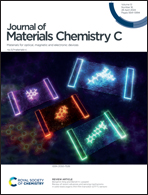Conducting polymer films and bioelectrodes combining high adhesion and electro-mechanical self-healing†
Abstract
Self-healable, conductive, soft, and stretchable electronic materials have become research hotspots in wearable and bioelectronic devices for healthcare monitoring. In this study, conductive, soft, stretchable, self-healing, highly adhesive, and biocompatible conductive polymer films were obtained by mixing poly(3,4-ethylenedioxythiophene) doped with polystyrene sulfonate (PEDOT:PSS), ethylene glycol (EG), and tannic acid (TA). The films with optimized composition demonstrated very attractive properties for wearable electronics and bioelectronics, including a conductivity of ∼17 S cm−1, a low Young's modulus of ∼450 kPa, stretchability of ∼90% strain, outstanding electrical stability during stretching (2% resistance change at 30% strain), and strong adhesion on several substrates. Notably, the films exhibited outstanding autonomous and cut-stick healing properties, enabled by the addition of TA. Furthermore, the films exhibited no signs of cytotoxicity, making them suitable for biomedical applications. Epidermal electrodes prepared using these materials exhibit low skin-electrode impedance at low frequencies (1–100 Hz) and high quality for electrocardiography (ECG) and electromyography (EMG) signal recordings. This study promotes the development of innovative wearable biomedical devices and contribute to personalized healthcare monitoring.

- This article is part of the themed collection: 2024 Journal of Materials Chemistry C Most Popular Articles


 Please wait while we load your content...
Please wait while we load your content...